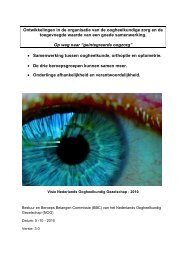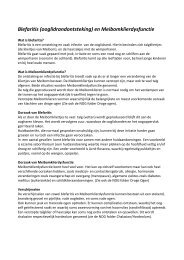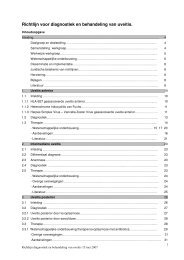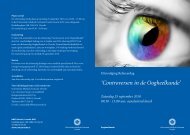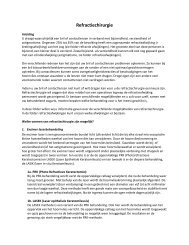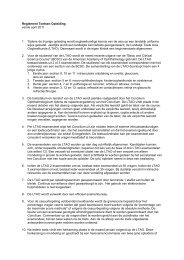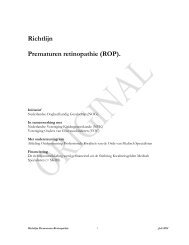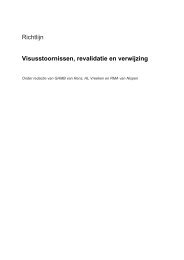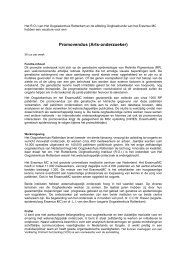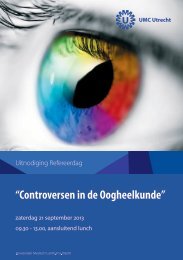terminology and guidelines for glaucoma ii - Kwaliteitskoepel
terminology and guidelines for glaucoma ii - Kwaliteitskoepel
terminology and guidelines for glaucoma ii - Kwaliteitskoepel
Create successful ePaper yourself
Turn your PDF publications into a flip-book with our unique Google optimized e-Paper software.
1.5 - BLOOD FLOW<br />
1.5.1 - VASCULAR FACTORS AND GLAUCOMA<br />
Factors involved in the aetiology <strong>and</strong> progression of <strong>glaucoma</strong>tous optic neuropathy are not only pressure dependent<br />
<strong>and</strong> are also related to the vascular supply of the optic nerve head.<br />
Many observations indicate the need to study the relationship between blood flow <strong>and</strong> <strong>glaucoma</strong>:<br />
- existence of normal tension <strong>glaucoma</strong> (NTG) 1-4<br />
- presence of disc haemorrhages in <strong>glaucoma</strong> patients<br />
- higher prevalence of retinal vein occlusion in <strong>glaucoma</strong> patients<br />
- association of NTG <strong>and</strong> migraine, Raynaud’s phenomenon, vasospasm 5,6,7<br />
- association of NTG <strong>and</strong> systemic hypotension <strong>and</strong> excessive number of nocturnal “dips” in diastolic blood pressure 8,9<br />
- association of <strong>glaucoma</strong> <strong>and</strong> abnormal blood coagulability profile 10,11<br />
- association of NTG <strong>and</strong> silent myocadial ischaemia 9<br />
- association of <strong>glaucoma</strong> (NTG) <strong>and</strong> cerebral infarcts 12,16<br />
- association of NTG <strong>and</strong> an history of hypotensive shock or episode of severe blood loss. 5<br />
1.5.2 - MEASUREMENTS METHODS OF OCULAR BLOOD FLOW<br />
Many methods have been used to calculate ocular blood flow: fluorescein angiography 14,15 , scanning laser ophthalmoscope<br />
16 , videoangiography 17,18 , laser Doppler velocimetry 19,20 , laser speckle phenomenon, blue field entoptic phenomenon<br />
21 , pulsatile ocular blood flow 22 , colour Doppler imaging 23,24 , oculodynamography 25-27 . For technical reasons, wide<br />
interindividual variations can occur with problems related to posture, as well as technician experience, patient cooperation.<br />
Multiple measurements are there<strong>for</strong>e required. More importantly in <strong>glaucoma</strong>, it is relevant to measure the<br />
blood supply to the retrolaminar portion of the optic nerve head, i.e. small vessels which are difficult to visualise <strong>and</strong><br />
have wide anatomic variability.<br />
The number of methods used illustrate the difficulty of measurements of ocular blood flow relative to the blood supply<br />
of the optic nerve head, size of of vessels, individual variations, reproducibility of measurements techniques.<br />
At the present time the clinical role of blood flow measurements in <strong>glaucoma</strong> management (<strong>and</strong> the relevance of changes<br />
noted with drug treatments) are unclear <strong>and</strong> these techniques remain research tools.<br />
However clinical vascular risk factors should be taken into account in <strong>glaucoma</strong> management especially when the<br />
IOP is low (over 24 hours <strong>and</strong> with normal CCT) <strong>and</strong> visual fields show severe <strong>and</strong> progressive alteration 28 .<br />
1.6 - AXIAL LENGTH MEASUREMENTS<br />
For follow-up of congenital <strong>glaucoma</strong> axial length measurement is a useful tool, especially to correlate with IOP findings,<br />
refraction <strong>and</strong> corneal diameter 29,30 .<br />
Ch. 1 - 33 EGS



